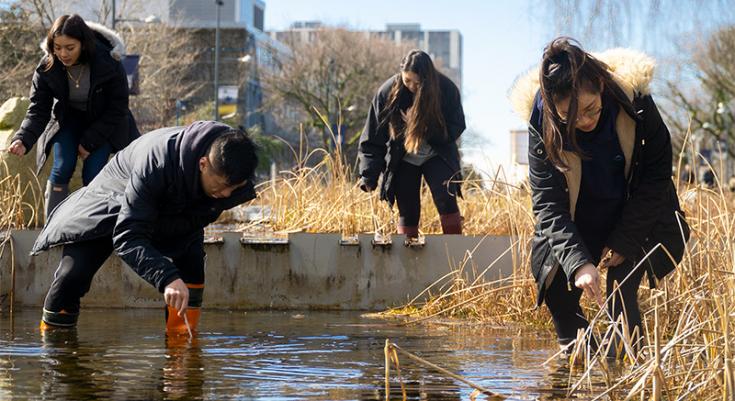
A stepped water feature in the centre of campus surprises with its rich aquatic life and potential as a site for demonstrating biodiversity.
When an algae bloom occurred last summer in the water feature on University Boulevard, Doug Doyle, Associate Director, Municipal Engineering at Campus and Community Planning and Clayton McMullen, Head Plumber at UBC Building Operations pondered what to do about the issue.
“We thought the bloom was due to a buildup of nutrients from the collection and recycling of rain water harvested from Main Mall. Control and management of the algae with chemicals was not a sustainable practice.” said Doyle.
With the help of the SEEDS Sustainability Program, Doyle presented the problem to the Community Project in Environmental Science class (ENVR 400) taught by Michael Lipsen and Tara Ivanochko in the Department of Earth, Ocean and Atmospheric Sciences. Each year, students in the project-based class collaborate with community partners to investigate environmental issues, and work with SEEDS to identify campus-based projects. Following Doyle’s presentation, fourth year students Melissa Lin, Jeff Sha, Samantha Lee-Wardell and Alene Wong were eager to take up the research challenge.
In Fall 2018, the student team began their research with the hypothesis that a heatwave in summer 2018 had caused an increase in nutrients in the water feature leading to the algae bloom.
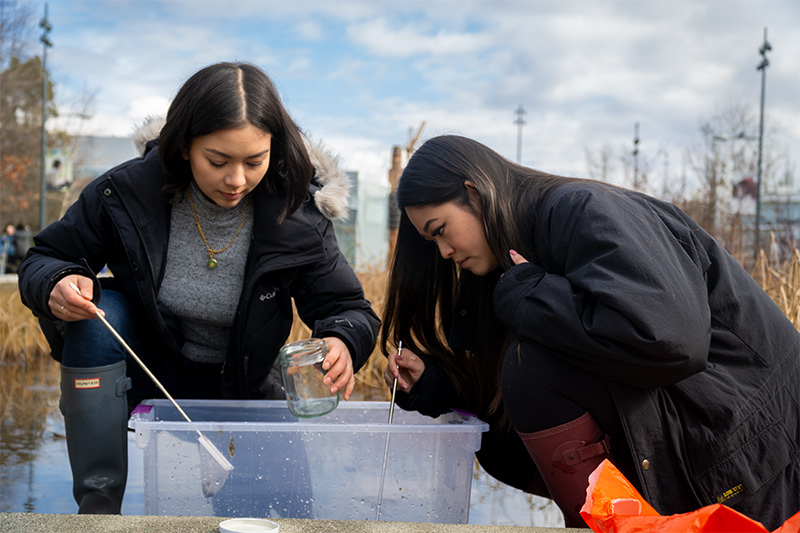
Environmental Science students Samantha Lee-Wardell and Melissa Lin conduct sampling in the water feature on University Boulevard. Photo by Matthew Taylor.
The team conducted biweekly samples of water and algae in the water feature, testing for nutrients such as ammonia to learn more about the aquatic environment. Viewing the water under a microscope they discovered it was teeming with microalgae such as freshwater diatoms, Cosmarium, and Chromulina.
They found that the majority of algae in the water feature was Mougeotia spp. A literature review revealed that it was an extremely resilient type that would outperform other algae due to a lack of natural predators. They discovered this type of algae bloomed in water with limited nutrients and could survive in a wide range of pH levels. This was a major finding for the team and debunked the idea that the algae growth was due to a high amount of nutrients from rainwater run-off from lawn areas on Main Mall.
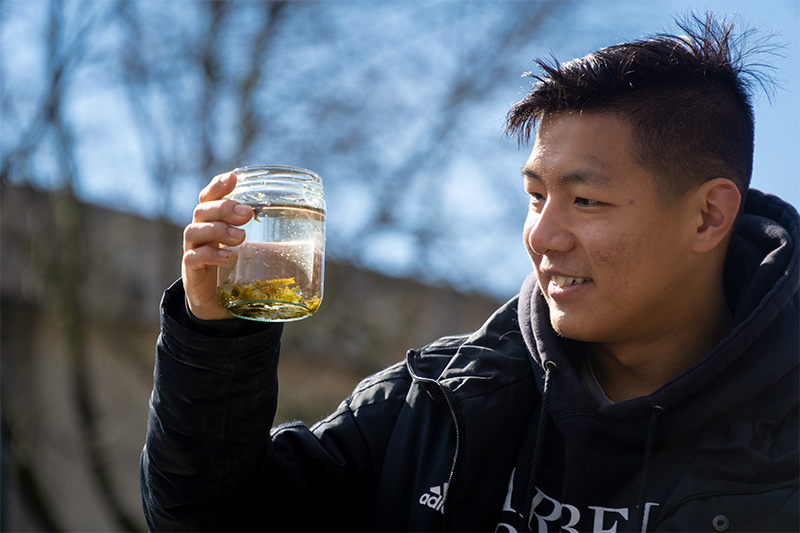
Jeff Sha takes a look at a sample taken from the rainwater fountain. Photo by Matthew Taylor.
Demonstrating biodiversity
In Spring 2019, the students switched their focus from ways to limit the algae to ways of working with it. “It’s very difficult to reduce the algae because it’s a really resilient species,” said Melissa Lin.
The team began investigating the water feature’s aquatic biodiversity. They discovered it was teeming with aquatic insects including Mayfly (Baetidae Baetis sp.), Midges (Chironomidae), Backswimmer (Notonecta kirbyi), Damselfly (Odonata Zygoptera) and Dragonfly larvae (Odonata Anisoptera). They also discovered freshwater zooplankton which consumes algae and bacteria, and microscopic organisms such as nematode and rotifer which both feed on organic particles and algae.
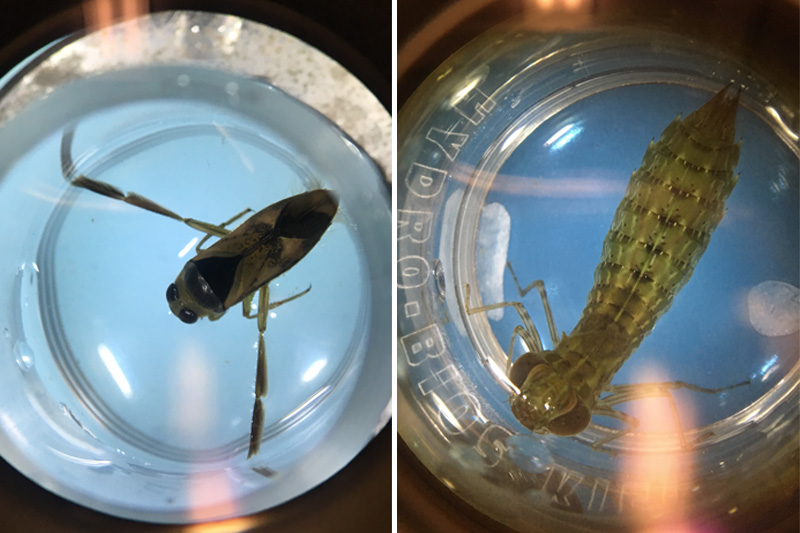
Close-up photos taken through a microscope by the students show Backswimmer (Notonecta kirbyi) on left and Dragonfly larvae (Odonata Anisoptera) on the right. Photos by Melissa Lin.
“It’s interesting to see how these little bugs that you never think about, the baby versions, are the most important part of the life cycle. In the larvae state they decompose all the leaf litter in the water feature and recontribute all the nutrients into an organic form that all the plants and the algae can use,” said Samantha Lee-Wardell of the group’s findings.
In their research they found that pressure washing the water feature would be fatal to many of the insects living there. “Every time Building Operations cleans up the water feature it actually resets the dragonfly life cycle back to zero and that’s why they’ve stopped seeing dragonflies here. They need 2-3 years undisturbed to mature,” said Lee-Wardell.
In consultation with university experts such as Karen Needham, an Aquatic Entomologist from the Beaty Biodiversity Research Centre, they recommended that the biodiversity in the water feature be preserved and enhanced. “We thought why don’t we make this a biodiversity learning lab instead and support UBC’s goals in providing a sustainable and biodiverse campus,” said Lin.
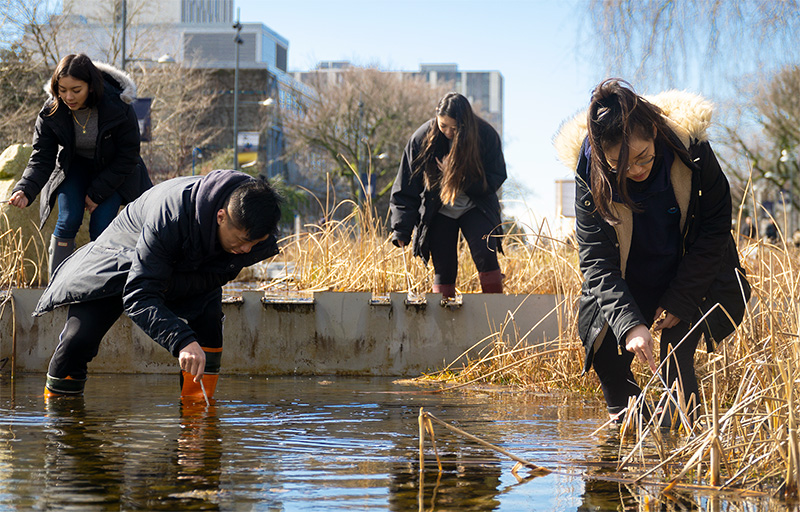
The team investigates the fountain on University Boulevard. From left: Samantha Lee-Wardell, Jeff Sha, Melissa Lin, and Alene Wong. Photo by Matthew Taylor.
This project sparked the curiosity of passerbys each time the team entered the water feature. “So many people came up to us and asked “What are you doing? What are you investigating?” said Lee-Wardell. “It’s pretty evident that many people are interested in what’s going on with the water feature. And everyone loves that we want to increase biodiversity instead of removing all the algae. People respond better when you are doing something in line with stated UBC goals.”
The team suggested that the centrally located water feature could be listed with online citizen science websites such as iNaturalist and become part of the international Bioblitz movement. Citizen scientists could observe the plants, insects and birds around the water feature and put UBC on the biodiversity map.
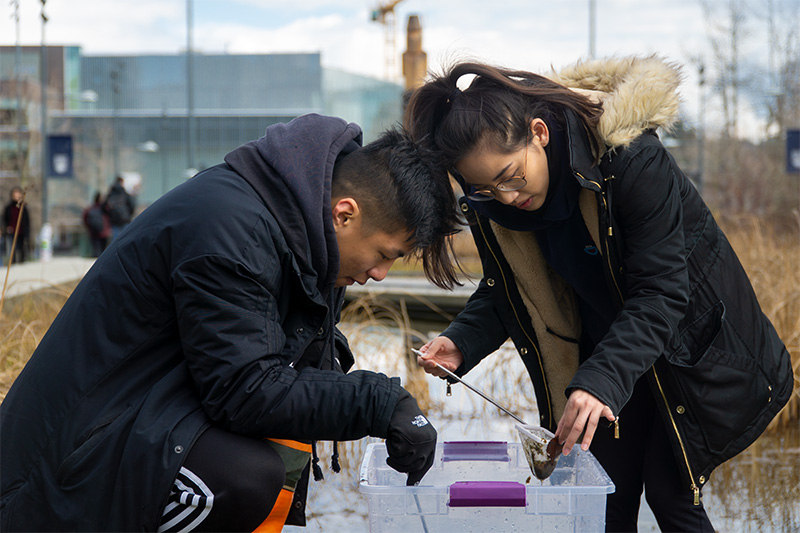
Jeff Sha and Alene Wong use small nets to remove leaves and other matter from their samples. Photo by Matthew Taylor.
The team recently presented their recommendations to Building Operations and Campus and Community Planning. These included adjusting maintenance practices so as to minimize disruption to aquatic species, planting native species, adding signage to educate the public about the life in the water feature, and forming new SEEDS collaborations with UBC courses and Beaty Biodiversity Research Centre.
UBC has taken these recommendations on board and agreed to change their maintenance practices in the fountain. They will no longer wash out the fountain as was done previously and landscaping crews will selectively pull back some of the plantings as they grow rather than cutting them back completely. This will allow the plants to grow undisturbed for a couple of years. A suggestion from the students to add potted lily pads to the feature will be explored as time and budget allows.
Maintaining the water feature as a biodiversity site aligns with the Campus Biodiversity Initiative: Research & Demonstration (CBIRD), a hub of urban biodiversity projects throughout campus managed by the SEEDS Sustainability Program. It is also relevant to UBC’s 20-Year Sustainability Strategy, Integrated Stormwater Management Plan, and broader whole systems planning.
The journey from removing algae to preserving the water feature’s biodiversity was valuable for the staff involved in the project. “We found the algae in the water feature is tough and won’t go away. We’ve also realized that we have to learn to live with it and leverage its presence into something positive. Changing how we see the water feature is key to changing the paradigm," said Doyle.